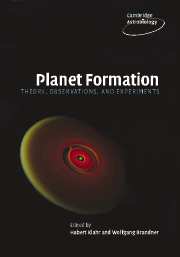Book contents
- Frontmatter
- Contents
- Preface
- Acknowledgments
- 1 Historical notes on planet formation
- 2 The Formation and Evolution of Planetary Systems: placing our Solar System in context
- 3 Destruction of protoplanetary disks by photoevaporation
- 4 Turbulence in protoplanetary accretion disks: driving mechanisms and role in planet formation
- 5 The origin of solids in the early Solar System
- 6 Experiments on planetesimal formation
- 7 Dust coagulation in protoplanetary disks
- 8 The accretion of giant planet cores
- 9 Planetary transits: a first direct vision of extrasolar planets
- 10 The core accretion–gas capture model for gas-giant planet formation
- 11 Properties of exoplanets: a Doppler study of 1330 stars
- 12 Giant-planet formation: theories meet observations
- 13 From hot Jupiters to hot Neptunes … and below
- 14 Disk–planet interaction and migration
- 15 The brown dwarf–planet relation
- 16 Exoplanet detection techniques – from astronomy to astrobiology
- 17 Overview and prospective in theory and observation of planet formation
- References
- Index
16 - Exoplanet detection techniques – from astronomy to astrobiology
Published online by Cambridge University Press: 14 September 2009
- Frontmatter
- Contents
- Preface
- Acknowledgments
- 1 Historical notes on planet formation
- 2 The Formation and Evolution of Planetary Systems: placing our Solar System in context
- 3 Destruction of protoplanetary disks by photoevaporation
- 4 Turbulence in protoplanetary accretion disks: driving mechanisms and role in planet formation
- 5 The origin of solids in the early Solar System
- 6 Experiments on planetesimal formation
- 7 Dust coagulation in protoplanetary disks
- 8 The accretion of giant planet cores
- 9 Planetary transits: a first direct vision of extrasolar planets
- 10 The core accretion–gas capture model for gas-giant planet formation
- 11 Properties of exoplanets: a Doppler study of 1330 stars
- 12 Giant-planet formation: theories meet observations
- 13 From hot Jupiters to hot Neptunes … and below
- 14 Disk–planet interaction and migration
- 15 The brown dwarf–planet relation
- 16 Exoplanet detection techniques – from astronomy to astrobiology
- 17 Overview and prospective in theory and observation of planet formation
- References
- Index
Summary
Introduction: planet detection and studies in the historical context
Beyond Earth, only five planets have been known since historical times. These are the three “terrestrial planets,” Mercury, Venus and Mars, and the two “gas giants,” Jupiter and Saturn. The systematic studies of the skies starting in the seventeenth century marked the beginning of a new era. The ice giant Uranus, the next outer planet beyond Saturn, was first cataloged as 34 Tau by John Flamsteed in 1690, but not recognized as a “wanderer” in the skies. In 1781 William Herschel was the first to spatially resolve the disk of Uranus, initially classifying it as a comet. Uranus also played an important role in the discovery of Neptune. Neptune, the eighth planet in the Solar System, and the outermost of the ice giants, was first observed in 1612/1613 by Galileo Galilei. At that time, Neptune was in close conjunction with Jupiter. Galileo recognized the moving source in the vicinity of Jupiter (see Fig. 16.1), but decided not to get distracted from his studies of the orbital motions of Jupiter's four largest moons, which we now refer to as “Galilean Moons.” Another 230 years passed till precise measurements of Uranus' orbit indicated the presence of an additional outer planet. Based on predictions by Urbain Leverrier (which were in close agreement with independent calculations by John Couch Adams) in 1846, Johann Gottfried Galle finally identified and resolved Neptune.
- Type
- Chapter
- Information
- Planet FormationTheory, Observations, and Experiments, pp. 250 - 255Publisher: Cambridge University PressPrint publication year: 2006

